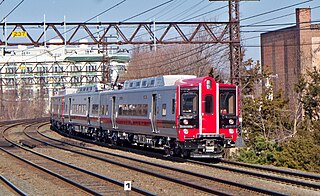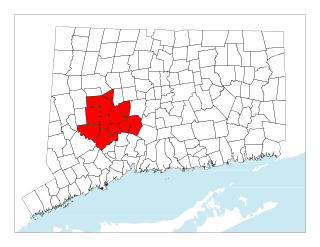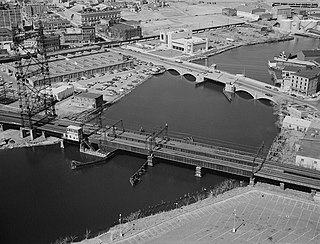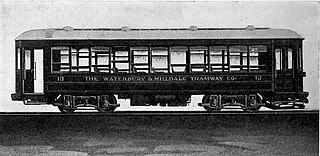Related Research Articles

The New York, New Haven and Hartford Railroad, commonly known as The Consolidated, or simply as the New Haven, was a railroad that operated principally in the New England region of the United States from 1872 to December 31, 1968. Founded by the merger of the New York and New Haven and Hartford and New Haven railroads, the company had near-total dominance of railroad traffic in Southern New England for the first half of the 20th century.

The New York and New England Railroad (NY&NE) was a railroad connecting southern New York State with Hartford, Connecticut; Providence, Rhode Island; and Boston, Massachusetts. It operated under that name from 1873 to 1893. Prior to 1873 it was known as the Boston, Hartford and Erie Railroad, which had been formed from several smaller railroads that dated back to 1846. After a bankruptcy in 1893, the NY&NE was reorganized and briefly operated as the New England Railroad before being leased to the competing New York, New Haven and Hartford Railroad in 1898.

The New Haven Line is a 72.7 mi (117.0 km) commuter rail line operated by the Metro-North Railroad in the U.S. states of New York and Connecticut. Running from New Haven, Connecticut, to New York City, the New Haven Line joins the Harlem Line in Mount Vernon, New York, and continues south to Grand Central Terminal in Manhattan. The New Haven Line carries 125,000 passengers every weekday and 39 million passengers a year. The busiest intermediate station is Stamford, with 8.4 million passengers, or 21% of the line's ridership.

The Housatonic Railroad is a Class III railroad operating in southwestern New England and eastern New York. It was chartered in 1983 to operate a short section of ex-New York, New Haven and Hartford Railroad in northwestern Connecticut, and has since expanded north and south, as well as west into New York State.

The Danbury Branch is a diesel branch of the Metro-North Railroad's New Haven Line in the U.S. state of Connecticut, running from downtown Norwalk north to Danbury. It opened in 1852 as the Danbury and Norwalk Railroad. Until the early 1970s, passenger service continued north from Danbury to Canaan, Connecticut, and Pittsfield, Massachusetts. Metro-North took over operation of the line from Conrail in 1983, and the modern-day branch is mostly single-tracked.

The Naugatuck Railroad is a common carrier railroad owned by the Railroad Museum of New England and operated on tracks leased from the Connecticut Department of Transportation. The original Naugatuck Railroad was a railroad chartered to operate through south central Connecticut in 1845, with the first section opening for service in 1849. In 1887 the line was leased by the New York, New Haven and Hartford Railroad, and became wholly owned by 1906. At its greatest extent the Naugatuck ran from Bridgeport north to Winsted. Today's Naugatuck Railroad, formed in 1996, runs from Waterbury to the end of track in Torrington, Connecticut. From Waterbury south to the New Haven Line, Metro-North Railroad operates commuter service on the Waterbury Branch.

The Waterbury Branch is a branch of the Metro-North Railroad's New Haven Line, running north from a junction in the Devon section of Milford to Waterbury, Connecticut. Originally built as the Naugatuck Railroad, it once continued north to Winsted. The part north of Waterbury is now leased from CDOT by the Railroad Museum of New England, which operates excursion trains from Thomaston station through their operating subsidiary Naugatuck Railroad ; this name was chosen in homage of the original railroad. The trackage ends in Torrington, but Metro-North service on the branch ends at Waterbury. There are conceptual plans to extend service from its current terminus in Waterbury to Hartford via Bristol and New Britain. Currently, riders that want to continue to New Britain and Hartford have to transfer to an express bus operated by CTtransit at Waterbury. All trains on this branch operate as shuttles between Waterbury and Bridgeport.

CT Transit is a public transportation bus system serving many metropolitan areas and their surrounding suburbs in state of Connecticut. CT Transit is a division of the Connecticut Department of Transportation, although it contracts a number of private companies for most of its operations. CT Transit began operations in 1976 as Connecticut Transit after the Connecticut DOT's acquisition of the Connecticut Company. Initially serving only the Hartford, New Haven, and Stamford areas, CT Transit's service now extends throughout much of Connecticut. CT Transit provides local "city bus" service in Bristol, Hartford, Meriden, New Britain, New Haven, Stamford, Wallingford and Waterbury in addition to a number of express routes connecting to outlying suburbs and other regions of the state.

Bridgeport-Stamford-Norwalk is a metropolitan area in the U.S. state of Connecticut. The area is located in Southwestern Connecticut. In its most conservative form the area consists of the city of Bridgeport and five surrounding towns—Easton, Fairfield, Monroe, Stratford, and Trumbull. This definition of the Bridgeport area has a population of more than 305,000 and is within the Bridgeport-Stamford-Norwalk-Danbury metropolitan statistical area, which consists of all of Fairfield County, Connecticut. The estimated 2015 county population was 948,053. The area is numbered as part of the New York-Newark Combined Statistical Area NY-NJ-CT-PA by the United States Census Bureau.

The Third Avenue Railway System (TARS), founded 1852, was a streetcar system serving the New York City boroughs of Manhattan and the Bronx along with lower Westchester County. For a brief period of time, TARS also operated the Steinway Lines in Long Island City.

The Connecticut Company was the primary electric street railway company in the U.S. state of Connecticut, operating both city and rural trolleys and freight service. It was controlled by the New York, New Haven and Hartford Railroad, which also controlled most steam railroads in the state. After 1936, when one of its major leases was dissolved, it continued operating streetcars and, increasingly, buses in certain Connecticut cities until 1976, when its assets were purchased by the state government.

The Central Naugatuck Valley is a region of Connecticut in New Haven and Litchfield counties located approximately 70 miles (110 km) northeast of New York City and 110 miles (180 km) southwest of Boston, United States. The region comprises 13 towns: Beacon Falls, Bethlehem, Cheshire, Middlebury, Naugatuck, Oxford, Prospect, Southbury, Thomaston, Waterbury, Watertown, Wolcott, and Woodbury.

The Connecticut Railway and Lighting Company Car Barn was historic streetcar maintenance facility in Bridgeport, Connecticut. Built in 1910 and enlarged in 1920, it served as a maintenance barn first for electric streetcars and then buses for many years, and was one of the few surviving reminders of the city's early public transit system. The building was listed on the National Register of Historic Places on December 3, 1987. It was demolished in 2008 to make way for construction of the Connecticut Superior Court juvenile facility that now stands on its site.
The Bridgeport Traction Company was a streetcar transit company in the area around Bridgeport, Connecticut. The company was incorporated in 1893 through the consolidation of the Bridgeport Horse Railroad Company, Bridgeport Railway Company, and the East End Railway Company. The East End Railway Company was established in 1895 as the Bridgeport and West Stratford Horse Railroad Company. The Bridgeport Horse Railroad Company was incorporated in 1864. The Bridgeport Railway Company was formed in 1893. At the time, streetcars were a more affordable form of transportation for those commuting between Bridgeport and Norwalk. Using streetcars to get to their destination was half the price of using the train. In 1899 president Andrew Radel formed a company that was intended to control the world's oyster trade.

The New York and Stamford Railway was a streetcar line that connected the Westchester County suburbs of New Rochelle, Larchmont, Mamaroneck, Harrison, Rye, and Port Chester, with the Connecticut suburbs of Greenwich and Stamford. The company was formed in 1901 when the New York, New Haven and Hartford Railroad combined the Larchmont Horse Railway Company with the Port Chester Street Railroad Company. The Larchmont Horse Railway Company was founded in 1888 by the Larchmont Manor Company to construct a line from the New York, New Haven and Hartford Railroad Larchmont train station to its development 1.2 miles from town. The line was rebuilt for electric operation and extended to Harrison in 1901. The Port Chester Street Railroad opened in 1898 serving Port Chester, New York. The trolley line was soon extended west through Rye to Harrison in 1901. The two companies were merged that summer to form the New York and Stamford Railway. Trackage rights over the Westchester Electric Railroad were obtained for access to New Rochelle.

The Danbury and Bethel Street Railway was a streetcar transit operator serving the greater Danbury, Connecticut, area, originally chartered in 1886. It was one of the few trolley companies to remain independent of the Connecticut Company consolidation of transit lines throughout the state. Electric trolley service between Danbury and Bethel began in 1887. The streetcar line connected to the Danbury and Harlem Traction Company at the Fairgrounds, but no service was provided and the line was abandoned by 1910. The Danbury and Bethel Street Railway faced its first financial difficulties in 1914 as ridership declined with the closure of local factories. The construction of an aborted extension to Bridgeport had nearly exhausted the railway's cash reserves. The company was purchased by J. Moss Ives in 1918 with the intention of bringing the operation back to profitability. The first buses were ordered and put into operation in 1912 between Main Street and Lake Avenue in Danbury. Ives reorganized as the Danbury and Bethel Traction Company in 1925. When the proposal to replace all remaining streetcar lines with bus operation was announced, the trolley motormen all went on strike in November 1926. The work stoppage did not affect the transition, and by the end of 1926 all streetcar operation had been abandoned, making it the first line in Connecticut to completely convert to bus operation.
The Waterbury Traction Company was a streetcar transit operator serving the region around Waterbury, Connecticut. Originally formed in 1884 as the Waterbury Horse Railroad Company, which began service in 1886. The company was reorganized in 1893 as the Waterbury Traction Company, rebuilding and electrifying its routes by the summer of 1894.

The Meriden, Waterbury, and Connecticut River Railroad was a railroad in the state of Connecticut. The charter, originally granted in 1871 to the Meriden and Cromwell Railroad, was obtained by Meriden residents and construction began in 1883. The line opened between the city of Meriden, Connecticut, and the Connecticut River in Cromwell, Connecticut, in 1885. An extension to Waterbury, Connecticut, was completed in 1888 as the Meriden and Waterbury Railroad, and the two companies merged to form the Meriden, Waterbury and Connecticut Railroad.

The Waterbury and Milldale Tramway was a streetcar line that operated between Waterbury and Milldale, Connecticut, United States. The line was 8.702 miles (14.00 km) long, including 1.385 miles (2.23 km) of trackage rights on a Connecticut Company line to reach downtown Waterbury. The company was chartered in June 1907 and began construction in mid-1912. It opened in stages, with the first section entering service on November 19, 1913, and the full line open on December 19, 1914. The line was soon unprofitable; the east portion was abandoned in October 1927, and the remainder in October 1933. A bus route that replaced the western portion continues to run as CTtransit route 425, operated by the Northeast Transportation Company. The Waterbury and Milldale was locally known as the "Green Line" after its green-painted streetcars, which included a pair of unique cars.
References
- ↑ Report of the Board of Railroad Commissioners, the Tax Commissioner and the Bank Commissioner, Sitting as a Commission, Relative to the Assets and Liabilities of the New York, New Haven & Hartford Railroad Company, Feb. 15, 1911. Wright & Potter Printing Co. 1911. p. 486.
- ↑ Report of the Board of Railroad Commissioners, the Tax Commissioner and the Bank Commissioner, Sitting as a Commission, Relative to the Assets and Liabilities of the New York, New Haven & Hartford Railroad Company, Feb. 15, 1911. Wright & Potter Printing Co. 1911. p. 487.
- ↑ Hartford Courant, Conn. Co. Will Quit Leased Lines Monday, November 14, 1936, p. 1
- ↑ The New York Times , Buses for Bridgeport, February 10, 1937, p. 5